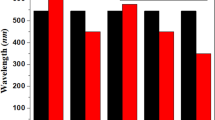Abstract
We developed novel fluorine and nitro-containing stilbene-linked carbazole-based fullerene (C60) derivatives for bulk heterojunction organic solar cells (BHJ-OSCs). The synthesized fullerene derivatives (FCzC61BM and NCzC61BM) have hexyl chains that possess good solubility in toluene and chlorobenzene organic solvents. The extended conjugation of FCzC61BM and NCzC61BM molecules showed broad absorption with strong absorption intensity. The FCzC61BM and NCzC61BM both have a low-lying lowest unoccupied molecular orbital (LUMO) level of − 3.70 eV and − 3.75 eV, respectively, due to extended conjugation with electron donor. These LUMO energy level was quite close to the donor (P3HT) LUMO energy level, which is essential for electron transport properties. The BHJ-OSC device was fabricated using FCzC61BM and NCzC61BM as the acceptors with commercially available P3HT donor materials using following configurations ITO/PEDOT:PSS/P3HT:acceptor/LiF/Al. The FCzC61BM-based device showed a maximum PCE of 0.86% with Jsc of 8.36 mA/cm2, Voc of 0.34 V and FF of 0.30. These findings clearly demonstrated that the inclusion of stilbene and carbazole in C60 acceptor derivatives exhibited superior optical and electrochemical properties, as well as photovoltaic performance. These findings will help to rationally design the new C60 acceptor for OSC applications in the near future.






Similar content being viewed by others
Data availability
The data that support the findings of this study are available from the corresponding author.
References
Adamo C, Jacquemin D (2013) The calculations of excited-state properties with time-dependent density functional theory. Chem Soc Rev 42:845–856
Alahmadi ANM (2022) Design of an efficient PTB7:PC70BM-based polymer solar cell for 8% efficiency. Polymers 14:889
Becke AD (1993) Density-functional thermochemistry. III the role of exact exchange. J Chem Phys 98:5648–5652
Biglova YN (2021) [2 + 1] Cycloaddition reactions of fullerene C60 based on diazo compounds. Beilstein J Org Chem 17:630–670
Brabec CJ, Gowrisanker S, Halls JJM, Laird D, Jia S, Williams SP (2010) Polymer-fullerene bulk-heterojunction solar cells. Adv Mater 22:3839–3856
Chen TL, Zhang Y, Smith P, Tamayo A, Liu Y, Ma B (2011) Diketopyrrolopyrrole-containing oligothiophene-fullerene triads and their use in organic solar cells. ACS Appl Mater Interfaces 3:2275–2280
Cui C, Li Y, Li Y (2017) Fullerene derivatives for the applications as acceptor and cathode buffer layer materials for organic and perovskite solar cells. Adv Energy Mater 7:1601251
Dennler G, Scharber MC, Brabec CJ (2009) Polymer-fullerene bulk-heterojunction solar cells. Adv Mater 21:1323–1338
Frisch, M. Trucks, G. Schlegel, H. Scuseria, G. Robb, M. Cheeseman, J. Scalmani, G.Barone, V. Mennucci, B. Petersson, G. (2009) Gaussian 09, Revision D. 01, Gaussian, Inc., Wallingford CT. See also: URL. gaussian. com.
Ganesamoorthy R, Sathiyan G, Sakthivel P (2017) Review: fullerene based acceptors for efficient bulk heterojunction organic solar cell applications. Sol Energy Mater Sol Cells 161:102–148
Gégout A, Nierengarten J-F, Delavaux-Nicot B, Duhayon C, Saquet A, Listorti A, Belbakra A, Chiorboli C, Armaroli N (2009) Fullerene derivatives functionalized with diethylamino-substituted conjugated oligomers: synthesis and photoinduced electron transfer. Chem Eur J 15:8825–8833
Hahn U, Vögtle F, Nierengarten J-F (2012) Synthetic strategies towards fullerene-rich dendrimer assemblies. Polymers 4:501–538
He Y, Li Y (2011) Fullerene derivative acceptors for high performance polymer solar cells. Phys Chem Chem Phys 13:1970–1983
He Y, Chen H-Y, Hou J, Li Y (2010) Indene−C60 bisadduct: a new acceptor for high-performance polymer solar cells. J Am Chem Soc 132:1377–1382
Jia L, Chen M, Yang S (2020) Functionalization of fullerene materials toward applications in perovskite solar cells. Mater Chem Front 4:2256–2282
Jiang K, Wei Q, Lai JYL, Peng Z, Kim HK, Yuan J, Ye L, Ade H, Zou Y, Yan H (2019) Alkyl chain tuning of small molecule acceptors for efficient organic solar cells. Joule 3:3020–3033
Kim HU, Mi D, Kim J-H, Park JB, Yoon SC, Yoon UC, Hwang D-H (2012) Carbazole-containing fullerene derivatives for P3HT-based bulk-heterojunction solar cells. Sol Energy Mater Sol Cells 105:6–14
Lee C, Yang W, Parr RG (1988) Development of the colle-salvetti correlation-energy formula into a functional of the electron density. Phys Rev B 37:785
Liu J, Qiu L, Shao S (2021) Emerging electronic applications of fullerene derivatives: an era beyond OPV. J Mater Chem C 9:16143–16163
Lu J, Ding J, Alem S, Wakim S, Tse S-C, Tao Y, Stupak J, Li J (2011) Synthesis of oligofluorene modified C60 derivatives for organic solar cell applications. J Mater Chem 21:4953–4960
Meng X, Bai Y, Xiao S, Zhang T, Hu C, Yang Y, Zheng X, Yang S (2016) Designing new fullerene derivatives as electron transporting materials for efficient perovskite solar cells with improved moisture resistance. Nano Energy 30:341–346
Mi D, Kim J-H, Yoon SC, Lee C, Lee J-K, Hwang D-H (2011) Synthesis and characterization of a novel fullerene derivative containing carbazole group for use in organic solar cells. Synth Met 161:1330–1335
Nagarjuna P, Chaturvedi N, Bagui A, Runjhun R, Garg A, Singh SP (2017) Solution-processed organic solar cells using new electron acceptor derived from naphthalene and fluorene unit. ChemistrySelect 2:7913–7917
Nelson J (2011) Polymer:fullerene bulk heterojunction solar cells. Mater Today 14:462–470
Nierengarten, J.-F. Eckert, J.-F. Nicoud, J.-F. Ouali, L. Krasnikov, V. Hadziioannou, G. (1999) Synthesis of a C60-oligophenylenevinylene hybrid and its incorporation in a photovoltaic device. Chem. Commun.: 617–618.
NitikaGupta, S. Dixit, S. K. Sharma, A.Vij, A.Bhatnagar, C. Kumari, A. Kumar, V. Bahal, B. M. Sharma, R. K. Bhatnagar, P. K. (2021) Mechanistic insights on improved performance of PCDTBT:PC71BM hetero-structured organic photovoltaic cells via interfacing CdSe/ZnS nanostructures. Appl. Nanosci.
Sakthivel P, Ban TW, Kim S, Kim S, Gal Y-S, Chae EA, Shin WS, Moon S-J, Lee J-C, Jin S-H (2013) Synthesis and studies of methyl ester substituted thieno-o-quinodimethane fullerene multiadducts for polymer solar cells. Sol Energy Mater Sol Cells 113:13–19
Sakthivel P, Kranthiraja K, Saravanan C, Gunasekar K, Kim HI, Shin WS, Jeong J-E, Woo HY, Jin S-H (2014) Carbazole linked phenylquinoline-based fullerene derivatives as acceptors for bulk heterojunction polymer solar cells: effect of interfacial contacts on device performance. J Mater Chem A 2:6916–6921
Sathiyan G, Sivakumar EKT, Ganesamoorthy R, Thangamuthu R, Sakthivel P (2016) Review of carbazole based conjugated molecules for highly efficient organic solar cell application. Tetrahedron Lett 57:243–252
Sathiyan G, Siva G, Prakash J, Swart HC, Sakthivel P (2018) Design and chemical engineering of carbazole-based donor small molecules for organic solar cell applications. J. Mater. Sci.: Mater Electron 29:14842–14851
Sathiyan G, Wang H, Chen C, Miao Y, Zhai M, Cheng M (2022) Impact of fluorine substitution in organic functional materials for perovskite solar cell. Dyes Pigm 198:110029
Tian C-B, Deng L-L, Zhang Z-Q, Dai S-M, Gao C-L, Xie S-Y, Huang R-B, Zheng L-S (2014) Bis-adducts of benzocyclopentane- and acenaphthene-C60 superior to mono-adducts as electron acceptors in polymer solar cells. Sol Energy Mater Sol Cells 125:198–205
Uddin A (2022) Chapter 2 - Organic solar cells. In comprehensive guide on organic and inorganic solar cells, Akhtaruzzaman, M.; Selvanathan, V., Eds. Academic Press pp 25–55
Wang H-E, Liu Z (2022) Ternary organic solar cells with double side chain fullerene derivative as guest electron acceptors in PM7:Y6 blend films. Org Electron 103:106465
Zhang C, Chen S, Xiao Z, Zuo Q, Ding L (2012) Synthesis of Mono- and bisadducts of thieno-o-quinodimethane with C60 for efficient polymer solar cells. Org Lett 14:1508–1511
Zhao Y, Wang X, Yu T, Zhang H, Wei C, Liu X (2017) Synthesis and photovoltaic properties of carbazole-substituted fullerene derivatives. New J Chem 41:4702–4706
Zhuang T, Wang X-F, Sano T, Hong Z, Yang Y, Kido J (2013) Fullerene derivatives as electron donor for organic photovoltaic cells. Appl Phys Lett 103:203301
Acknowledgements
The authors are thankful to VIT University for providing laboratory facilities and VIT SIF for the spectral studies. The authors thank the DST for the financial support of this work through the SERB research grant (SERB-SB/FT/CS-185/2011) and Solar Energy Research Initiative (SERI) Programme (DST/TM/SERI/FR/172(G)).
Author information
Authors and Affiliations
Corresponding authors
Ethics declarations
Conflict of interest
The authors declare that they have no conflict of interest.
Additional information
Publisher's Note
Springer Nature remains neutral with regard to jurisdictional claims in published maps and institutional affiliations.
Supplementary Information
Below is the link to the electronic supplementary material.
Rights and permissions
Springer Nature or its licensor (e.g. a society or other partner) holds exclusive rights to this article under a publishing agreement with the author(s) or other rightsholder(s); author self-archiving of the accepted manuscript version of this article is solely governed by the terms of such publishing agreement and applicable law.
About this article
Cite this article
Sathiyan, G., Dasi, G., Ramasamy, S.K. et al. Stilbene-containing carbazole-based fullerene derivatives as alternative electron acceptor for efficient organic solar cells. Appl Nanosci 13, 4101–4108 (2023). https://doi.org/10.1007/s13204-022-02707-z
Received:
Accepted:
Published:
Issue Date:
DOI: https://doi.org/10.1007/s13204-022-02707-z




